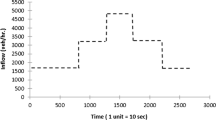Abstract
As network loading forms the basis of many dynamic traffic assignment solution algorithms, we consider in this paper four macroscopic link models that are widely used in DTA studies as the building blocks of certain network loading procedures. For the same generic link, the four models are solved and evaluated numerically for various link inflow profiles under a single-destination framework. And the characteristics of each model is analyzed and compared with others from multiple perspectives such as algorithmic implementation, model calibration, model accuracy, computational time and memory consumption. It is our purpose to find the best link model for the development of realistic and efficient network loading procedures. Moreover, since model discretization and calibration substantially influence a link model’s performance, both issues are carefully addressed in the paper.
Similar content being viewed by others
References
Astarita, V. (1996). “A Continuous Time Link Model for Dynamic Network Loading Based on Travel Time Function.” 13th International Symposium on Theory of Traffic Flow, pp. 79–103.
Carey, M. (1986). “A Constraint Qualification for a Dynamic Traffic Assignment Problem.” Transportation Science 20, 55–58.
Carey, M. (1987). “Optimal Time-Varying Flows on Congested Networks.” Operations Research 35, 58–69.
Carey, M. (2001). “Dynamic Traffic Assignment with More Flexible Modeling with Links.” Networks and Spatial Economics 1, 349–376.
Carey, M. and M. McCartney. (2002). “Behavior of a Whole-Link Travel Time Model Used in Dynamic Traffic Assignment.” Transportation Research Part B 36, 85–93.
Daganzo, C.F. (1994). “The Cell Transmission Model: A Simple Dynamic Representation of Highway Traffic Consistent with the Hydrodynamic Theory.” Transportation Research Part B 28, 269–287.
Daganzo, C.F. (1995a). “The Cell Transmission Model ii: Network Traffic.” Transportation Research Part B 29, 79–93.
Daganzo, C.F. (1995b). “Properties of Link Travel Times Under Dynamic Loads.” Transportation Research Part B 29, 95–98.
Drissi-Kaitouni, O. and A. Hameda-Benchekroun. (1992). “A Dynamic Traffic Assignment Model and a Solution Algorithm.” Transportation Science 26, 119–128.
Friesz, T.L., D. Bernstein, N.J. Mehta, R.L. Tobin, and S. Ganjalizadeh. (1989). “Dynamic Network Traffic Assignment Considered as a Continuous Time Optimal Control Problem.” Operations Research 37, 893– 901.
Friesz, T.L., D. Bernetein, Z. Suo, and R.L. Tobin. (2001). “Dynamic Network User Equilibrium with State-Dependent Time Lags.” Networks and Spatial Economics 1, 319–348.
Friesz, T.L., D. Bernstein, T.E. Smith, R.L. Tobin, and B.W. Wie. (1993). “A Variational Inequality Formulation of the Dynamic Network Equilibrium Problem.” Operations Research 41, 179–191.
Gangi, D., M. Astarita, and V. Adamo. (1995). “Dynamic Network Loading Models and Algorithms for Explicit Simulations of Queue Effects and While-Trip-Re-Routing.” Seventh World Conference on Transportation Research.
Ge, Y.E. and M. Carey. (2002). “Link Outflow Rate Computing Under Continuous Dynamic Loads.” In K.C.P. Wang, G. Xiao, L. Nie, and H. Yang (eds.), Traffic and Transportation Studies, Proceedings of the 3rd International Conference on Traffic and Transportation Studies,Virginia: ASCE, pp. 770–777.
Kuwahara, M. and T. Akamatsu. (1997). “Decomposition of the Reactive Dynamic Assignment with Queues for a Many-to-Many Origin-Destination Pattern.” Transportation Research Part B 31.
Li, J., O. Fujiwara, and S. Kawakami. (2000). “A Reactive Dynamic User Equilibrium Model in Network with Queues.” Transportation Research Part B 34, 605–624.
Lighthill, M.J. and J.B. Whitham. (1955). “On Kinematic Waves. (i) Flow Modeling in Long Rivers. (ii) A Theory of Traffic Flow on Long Crowded Roads.” Proceedings of the Roy Society A 229, 291–345.
Lo, H.K. and W.Y. Szeto. (2002). “A Cell-Based Variational Inequality Formulation of the Dynamic User Optimal Assignment Problem.” Transportation Research Part B 36, 421–441.
Merchant, D.K. and G.L. Nemhauser. (1978a). “A Model and an Algorithm for the Dynamic Traffic Assignment Problem.” Transportation Science 12, 183–199.
Merchant, D.K. and G.L. Nemhauser. (1978b). “Optimality Conditions for a Dynamic Traffic Assignment Model.” Transportation Science 12, 200–207.
Nagurney, A. (1993). Network Economics: A Variational Inequality Approach, Vol. 1 of Advances in Computational Economics. Kluwer Academic.
Newell, G.F. (1993). “A Simplified Theory of Kinematic Waves in Highway Traffic, (i) General Theory; (ii) Queuing at Freeway Bottlenecks, (iii) Multi-Destination Flows.” Trans. Res. B 27, 281–313.
Nie, X. and H.M. Zhang. (2002a). “The Delay-Function-Based Link Models: Their Properties and Computational Issues.” Transportation Research Part B. (To appear).
Nie, X. and H.M. Zhang. (2002b). “Solving Dynamic User-Equilibrium Traffic Assignment Problems: A Comparative Study of Six Path-Based Algorithms.” Technical report, University of California, Davis. UCD-ITS-Zhang-2002-7.
Ran, B. and D. Boyce. (1996). Modeling Dynamic Transportation Networks: An Intelligent Transportation System Oriented Approach, 2nd edn. Springer.
Richards, P.I. (1956). “Shockwaves on the Highway.” Operations Research 4, 42–51.
Smith, M.J. (1983). “The Existence of an Equilibrium Distribution of Arrivals at a Single Bottleneck.” Transportation Science 18, 385–394.
Wie, B.W., R.L. Tobin, T.L. Friesz, and D. Bernstein. (1995). “A Discrete Time, Nested Cost Operator Approach to the Dynamic Network User Equilibrium Problem.” Transportation Science 29, 79–92.
Wu, J.H., Y. Chen, and M. Florian. (1998). “The Continuous Dynamic Network Loading Problem: A Mathematical Formulation and Solution Method.” Transportation Research Part B 32, 173–187.
Xu, Y.W., J.H. Wu, M. Florian, P. Marcotte, and D.L. Zhu. (1999). “Advances in the Continuous Dynamic Network Loading Problem.” Transportation Science 33, 341–353.
Zhang, H.M. and X. Nie. (2002). “Some Consistency Conditions for Dynamic Traffic Assignment Problems.” Networks and Spatial Economics (to appear).
Zhu, D. and P. Marcotte. (2000). “On the Existence of Solutions to the Dynamic User Equilibrium Problem.” Transportation Science 34(4), 402–414.
Ziliaskopoulos, A.K. (2000). “A Linear Programming Model for the Single Destination System Optimum Dynamic Traffic Assignment Problem.” Transportation Science 34, 37–49.
Author information
Authors and Affiliations
Corresponding author
Rights and permissions
About this article
Cite this article
Nie, X., Zhang, H.M. A Comparative Study of Some Macroscopic Link Models Used in Dynamic Traffic Assignment. Netw Spat Econ 5, 89–115 (2005). https://doi.org/10.1007/s11067-005-6663-6
Issue Date:
DOI: https://doi.org/10.1007/s11067-005-6663-6




